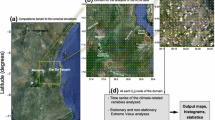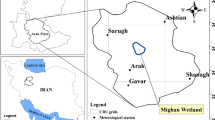Abstract
This paper introduces a framework for estimating stationary and non-stationary return levels, return periods, and risks of climatic extremes using Bayesian inference. This framework is implemented in the Non-stationary Extreme Value Analysis (NEVA) software package, explicitly designed to facilitate analysis of extremes in the geosciences. In a Bayesian approach, NEVA estimates the extreme value parameters with a Differential Evolution Markov Chain (DE-MC) approach for global optimization over the parameter space. NEVA includes posterior probability intervals (uncertainty bounds) of estimated return levels through Bayesian inference, with its inherent advantages in uncertainty quantification. The software presents the results of non-stationary extreme value analysis using various exceedance probability methods. We evaluate both stationary and non-stationary components of the package for a case study consisting of annual temperature maxima for a gridded global temperature dataset. The results show that NEVA can reliably describe extremes and their return levels.








Similar content being viewed by others
References
AghaKouchak A, Nasrollahi N (2010) “Semi-parametric and parametric inference of extreme value models for rainfall data.”. Water Resour Manag 24:1229–1249
AghaKouchak, A., D. Easterling, K. Hsu, S. Schubert, and S. Sorooshian (2013)“Extremes in a Changing Climate”, Springer, Netherlands.
Alexander, L.V., et al. (2006)“Global observed changes in daily climate extremes of temperature and precipitation.” Journal of Geophysical Research 111. D5.
Beguería S et al (2011) “Assessing trends in extreme precipitation events intensity and magnitude using nonstationary peaks-over-threshold analysis: a case study in northeast Spain from 1930 to 2006.”. Int J Climatol 31:2102–2114
Beniston M et al (2007) “Future extreme events in European climate: an exploration of regional climate model projections.”. Clim Chang 81:71–95
Cannon AJ (2011) “GEVcdn: An R package for nonstationary extreme value analysis by generalized extreme value conditional density estimation network. Comput Geosci 37:1532–1533
Coles, S., (2001)“An introduction to statistical modeling of extreme values” Springer, London.
Coles, S., E.A. Powell (1996)“Bayesian methods in extreme value modelling: a review and new developments.” International Statistical Review: 119–136
Cooley D (2009) “Extreme value analysis and the study of climate change.”. Climatic Change 97:77–83
Cooley, D. (2013)“Return periods and return levels under climate change”, Extremes in a Changing Climate. Springer Netherlands.
Cooley D et al (2007) “Bayesian spatial modeling of extreme precipitation return levels”. J Am Stat Assoc 102:824–840
Davison AC, Smith RL (1990) Models for exceedances over high thresholds. J R Stat Soc 393–442
Diffenbaugh NS, Giorgi F (2012) Climate change hotspots in the CMIP5 global climate model ensemble. Clim Chang 114(3–4):813–822
Easterling DR et al (2000) Climate extremes: observations, modeling, and impacts. Science 289:2068–2074
El Adlouni S et al (2007) Generalized maximum likelihood estimators for the nonstationary generalized extreme value model. Water Resour Res 43
Field, C.B., et al., (2012)Managing the Risks of Extreme Events and Disasters to Advance Climate Change Adaptation: Special Report of the Intergovernmental Panel on Climate Change. Cambridge University Press
Gelman, A., K. Shirley. (2011)“Inference from simulations and monitoring convergence” Handbook of Markov Chain Monte Carlo: 163–174.
Gelman, A., et al. (2003) “Bayesian data analysis” CRC Press
Gilleland, E., Katz, R.W. (2011)”New software to analyze how extremes change over time” Eos, 92 (2), 13—14.
Gumbel, E., (1942)“On the frequency distribution of extreme values in meteorological data”. B. Am. Meteorol. Soc., 23.
Gumbel, E.J. (1958)“Statistics of Extremes”, Mineola, NY: Dover.—, (1958)“Statistics of extremes”. Columbia University Press, New York.
Hao Z et al (2013) “Changes in concurrent monthly precipitation and temperature extremes. Environ Res Lett 8(4):034–014
IPCC (2007)“Climate Change 2007: The Physical Science Basis”, Working Group 1, IPCC Fourth Assessment Report, Cambridge University Press
Jakob D (2013) Nonstationarity in extremes and engineering design. Extremes in a Changing Climate, Netherlands
Kass RE, Raftery AE (1995) Bayes factors. J Am Stat Assoc 90(430):773–795
Katz R (2010) Statistics of extremes in climate change. Clim Chang 100(1):71–76
Katz, R.W. (2013)“Statistical methods for nonstationary extremes”. Extremes in a Changing Climate, Springer Netherlands.
Katz, R., et al., (2002)“Statistics of extremes in hydrology”. Advances in Water Resources, 25, 12871304.
Kendall, M.G. (1976)“Rank Correlation Methods”. 4thEd. Griffin.
Kharin VV, Zwiers FW (2005) “Estimating extremes in transient climate change simulations.”. J Clim 18:1156–1173
Kharin VV et al (2007) “Changes in temperature and precipitation extremes in the IPCC ensemble of global coupled model simulations.”. J Clim 20:1419–1444
Klein T., et al. (2009) Guidelines on Analysis of extremes in a changing climate in support of informed decisions for adaptation. WMO-TD 1500, 56 pp. Leadbetter, M., et al. (1983)“Extremes and related properties of random sequences and processes”.
Kundzewicz ZW, Robson AJ (2004) “Change detection in hydrological records—a review of the methodology”. Hydrol Sci J 49(1):7–19
Li Y, Cai W, Campbell EP (2005) Statistical modeling of extreme rainfall in southwest Western Australia. J Clim 18(6)
Mann HB (1945) “Nonparametric tests against trend”. Econometrica 13:245–259
Meehl GA et al (2000) “An introduction to trends in extreme weather and climate events: observations, socioeconomic impacts, terrestrial ecological impacts, and model projections”. Bull Am Meteorol Soc 81:413–416
Milly PCD et al (2008) Stationarity is dead: whither water management? Science 319:573–574
New M et al (2000) “Representing twentieth-century space-time climate variability. Part II: development of 1901–96 monthly grids of terrestrial surface climate.”. J Clim 13:2217–2238
Papalexiou, S.M., D. Koutsoyiannis (2013)“Battle of extreme value distributions: A global survey on extreme daily rainfall.” Water Resources Research.
Parey S et al (2010) “Different ways to compute temperature return levels in the climate change context.”. Environmetrics 21:698–718
Renard, B., et al. (2006)“An application of Bayesian analysis and Markov chain Monte Carlo methods to the estimation of a regional trend in annual maxima.” Water resources research 42.
Renard, B., et al. (2013)“Bayesian methods for non-stationary extreme value analysis”, Extremes in a Changing Climate, Springer.
Rootzén H, Katz RW (2013) “Design life level: quantifying risk in a changing climate”. Water Resour Res 49:5964–5972
Rosbjerg, R. and Madsen, H. (1998)“Design with uncertain design values, Hydrology in a Changing Environment”, Wiley, 155–163.
Salas JD, Obeysekera J (2013) Revisiting the concepts of return period and risk for nonstationary hydrologic extreme events. J Hydrol Eng. doi:10.1061/(ASCE)HE.1943-5584.0000820
Smith, R.L. (1987)“Estimating tails of probability distributions.” Ann. Stat.: 1174–1207
Smith R (2001) “Extreme value statistics in meteorology and environment. Environmental statistics”. Chapter 8:300–357
Smith RL (1989) “Extreme value analysis of environmental time series: an application to trend detection in ground-level ozone.”. Stat Sci 4:367–377
Stephenson A, Tawn J (2004) “Bayesian inference for extremes: accounting for the three extremal types.”. Extremes 7:291–307
Ter Braak CJF (2006) “A Markov chain monte Carlo version of the genetic algorithm differential evolution: easy Bayesian computing for real parameter spaces.”. Stat Comput 16:239–249
Ter Braak CJF, Vrugt JA (2008) “Differential evolution Markov chain with snooker updater and fewer chains.”. Stat Comput 18:435–446
Towler, E., B. Rajagopalan, et al., (2010)“Modeling hydrologic and water quality extremes in a changing climate: A statistical approach based on extreme value theory”, Water Resour. Res., 46.
Villarini G et al (2009) “Flood frequency analysis for nonstationary annual peak records in an urban drainage basin”. Adv Water Resour 32(8):1255–1266
Villarini, G., et al. (2011)“Annual maximum and peaks‐over‐threshold analyses of daily rainfall accumulations for Austria.” Journal of Geophysical Research 116. D5.
Vose, R.S., D.R. Easterling, B. Gleason. (2005)“Maximum and minimum temperature trends for the globe: An update through 2004.”Geophysical Research Letters 32.
Vrugt JA et al (2009) “Accelerating Markov chain monte Carlo simulation by differential evolution with self-adaptive randomized subspace sampling”. International Journal of Nonlinear Sciences and Numerical Simulation 10:273–290
Winkler, R.L. (1973)“A Bayesian approach to nonstationary processes”. IIASA.
Wu Z et al (2007) “On the trend, detrending, and variability of nonlinear and nonstationary time series.”. Proc Natl Acad Sci 104(38):14889–14894
Zhang X et al (2001) “Spatial and temporal characteristics of heavy precipitation events over Canada”. J Clim 14(9):1923–1936
Zhang X, Zwiers FW, Li G (2004) “Monte Carlo experiments on the detection of trends in extreme values.”. J Clim 17:1945–1952
Acknowledgements
The authors would like to thank Professor Balaji Rajagopalan for his thoughtful comments on an earlier draft of this paper. We also acknowledge the comments of Dr. Francesco Serinaldi and two other anonymous reviewers which led to substantial improvements in the current version. This study is supported by the National Science Foundation (NSF) Award No. EAR-1316536, and the United States Bureau of Reclamation (USBR) Award No. R11AP81451. The first author acknowledges partial financial support from the National Center for Atmospheric Research (NCAR) Graduate Student Visitor Program. NCAR is sponsored by the National Science Foundation.
Author information
Authors and Affiliations
Corresponding author
Electronic supplementary material
Below is the link to the electronic supplementary material.
ESM 1
(DOCX 509 kb)
Rights and permissions
About this article
Cite this article
Cheng, L., AghaKouchak, A., Gilleland, E. et al. Non-stationary extreme value analysis in a changing climate. Climatic Change 127, 353–369 (2014). https://doi.org/10.1007/s10584-014-1254-5
Received:
Accepted:
Published:
Issue Date:
DOI: https://doi.org/10.1007/s10584-014-1254-5




